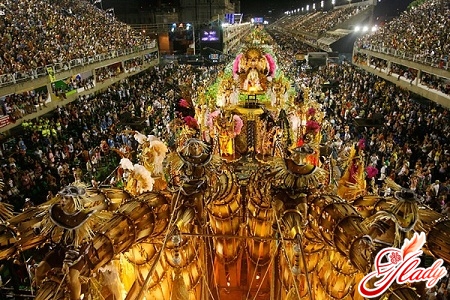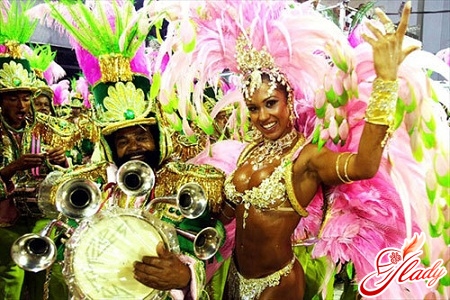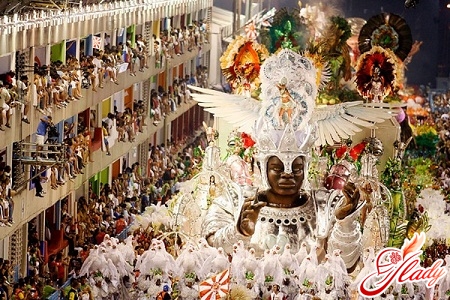 What people don’t do in an attempt to escape fromthe grayness of everyday life! Some people go on a trip to exotic countries, others master extreme sports. However, such activities may not be available to everyone for various reasons. And those who are completely desperate, shrug their shoulders, lie down on the sofa in front of the "blue screen" of the TV, trying to immerse themselves in the contemplation of other people's fun. Not a very attractive prospect, is it? But why not try to take part in some kind of holiday or carnival procession? The choice depends on the time of year, and it is huge on a planetary scale. Perhaps February can be considered the richest in numerous holidays and carnivals. At the end of February - beginning of March, a wave of carnivals rolls around the world. Here you have the Venetian carnival with magnificent masks, more like works of art, and the carnival in Dusseldorf, by the way - the longest in the world, with its eccentricities and comic processions. And the Goan carnival, with the three-day reign of King Moma. And the Mardi Gras carnival – the coveted dream of gourmets and hedonists all over the world. But the brightest and craziest can rightfully be called the Brazilian carnival. An exotic mixture of European sophistication and the primal passion of the peoples of Africa, conquering and infecting with its joy.
What people don’t do in an attempt to escape fromthe grayness of everyday life! Some people go on a trip to exotic countries, others master extreme sports. However, such activities may not be available to everyone for various reasons. And those who are completely desperate, shrug their shoulders, lie down on the sofa in front of the "blue screen" of the TV, trying to immerse themselves in the contemplation of other people's fun. Not a very attractive prospect, is it? But why not try to take part in some kind of holiday or carnival procession? The choice depends on the time of year, and it is huge on a planetary scale. Perhaps February can be considered the richest in numerous holidays and carnivals. At the end of February - beginning of March, a wave of carnivals rolls around the world. Here you have the Venetian carnival with magnificent masks, more like works of art, and the carnival in Dusseldorf, by the way - the longest in the world, with its eccentricities and comic processions. And the Goan carnival, with the three-day reign of King Moma. And the Mardi Gras carnival – the coveted dream of gourmets and hedonists all over the world. But the brightest and craziest can rightfully be called the Brazilian carnival. An exotic mixture of European sophistication and the primal passion of the peoples of Africa, conquering and infecting with its joy.
Moments of history
To this day, heated debates continue aboutWhere does the Brazilian carnival originate from? Many are sure that it began with the famous “funny processions” in Portugal. During these days, it was customary to make fun of each other, pour water on passersby, “shoot” paintballs, eggs, beans and flour. Girls from the balconies of houses aimed improvised projectiles directly at the heads of the guys they liked. Moreover, the “victim” of a precise hit was not offended, on the contrary - it was perceived as a kind of flirting and flirting. And it could serve as a basis for a closer acquaintance. It is believed that the basis of the carnival was pagan dances, when colorful processions passed through the streets of large and small cities. By the way, the tradition of decorating oneself with bright feathers originates from these dances. Of course, the church condemned the elements of paganism inherent in such folk festivities, but over time, as in the case of the Russian Maslenitsa, even timed these festivities to the last days before Lent. But the Brazilians would not be Brazilians if they did not introduce nuances to the carnival that are unique to this country. The history of the Brazilian carnival in the form in which it annually appears before numerous participants and guests dates back to 1916, when the first samba was written especially for the festive procession, which became the main attribute of the carnival. Already in 1928, the first samba schools appeared. And exactly four years later, the Brazilian carnival became a place for competitions between all these schools. And despite the fact that the carnival in Brazil is quite young, with the pressure inherent only to the temperamental Brazilians, it takes captive and conquers numerous hearts of true connoisseurs of the holidays.
In ecstasy of incendiary rhythm
Rio de Janeiro is Ostap Bender’s dream city.During the carnival, the air is somehow especially electrified. It seems that small sparks run across the skin, or an adrenaline shot is injected into the blood. Another second, and the holiday will fall like a tsunami wave, forcing you to choke with universal happiness and fun. During the week, life in Rio is subordinated to a single rhythm - the rhythm of samba. There is no place for cars and motorcycles on the numerous streets of the city. Only half-naked people dancing right in the middle of multi-lane roads. Temperamental Brazilians know a lot about fun, it is not for nothing that African, European and Indian traditions are intricately intertwined in the culture of this country. For five days, numerous samba schools compete with each other in the art of performing dances, the colorfulness of costumes and the design of special platforms. The center of Rio, Avenida Marques Sapucaí, where the Sambadrome is located - an alley thirteen meters wide and seven hundred meters long, turns into an open-air theater. This alley was designed in 1984 specifically for carnivals. The hearts of seventy thousand spectators seated in the stands beat in a single rhythm. Famous samba schools must show their skills in all their glory. In a strictly defined time, they must walk along the Sambadrome, performing dance steps. Several thousand people take part in the performance at the same time. By the way, the carnival in Rio de Janeiro is a democratic phenomenon, and it does not matter in which area of the city the samba school is located. It can be a school from a prestigious area - Grande Rio or from the favelas - Rocinha; everyone has the opportunity to become the best of the best. The official part of the carnival begins with the transfer of symbolic keys to the city to the "king of the carnival". He is given the symbolic right to issue and cancel any laws throughout the entire carnival. However, the main law of these days sounds quite clear - everyone have fun! And both the natives and the numerous tourists who have come specifically to watch this costumed dancing competition enthusiastically obey it. And the bravest decide to join. Having paid only 600 dollars, anyone can become part of the procession of one of the samba schools. The peak of the carnival is on Sunday and Monday, when the platforms representing the major league - the fourteen best schools of Brazil - take their place on the sambadrome. The anthem of the Brazilian carnival - the march "Spread Your Wings", written in 1899 by the composer Xquinha Gonzago - sounds. And the competition begins, invisible to the outside eye. Why invisible? It's very simple: looking at this fiery action, at the beautiful and hypnotizing movements of the dancers, it is impossible to believe that every movement, every smile and every look were rehearsed throughout the year. The strict jury, watching the carnival procession, carefully watches for the slightest inaccuracy in the dance pattern. A gap in the column of marchers or a sag in the plot line can lead to the fact that precious points will be deducted, and the dance school will be forced to look for new sponsors next year.
Feathers and rhinestones, or a masterpiece for one night
Certainly, when the phrase is mentioned"Brazilian carnival" clearly evokes in the mind a fantastic costume consisting of feathers and small pieces of fabric, decorated with rhinestones and glitter. After all, its main task is to emphasize the beautiful, well-trained body of the dancer, to distinguish him from the crowd and to designate the main theme of the holiday. Thus, costumes at the Brazilian carnival become full-fledged participants in the holiday. Every year, each of the hundreds of samba schools names a theme, or "enredo" in Portuguese, on which the composition of the dance is based. This means that the design of the dance platform and carnival costumes must exactly match and reveal the designated theme. Luxurious costumes, hand-embroidered with glass beads, beads and shells, cost a lot of money. Designers specially develop the design of carnival attire, trying to outdo each other. After all, this is their competition. Each pattern, each accessory of the carnival costume has its own meaning. And this is not without reason, since the tradition of wearing high headdresses decorated with feathers came to Brazil from Africa. Each such headdress is speaking, that is, it carries a certain meaning. Just like the embroidery inherited from the Indian tribes. Such costumes sometimes weigh a lot, up to fifty kilograms, and a fragile girl standing on a platform also needs to dance, and in such a way that no spectator notices the tension. And therefore, the comfort of the costume becomes one of the main criteria. Sometimes body art can become part of a carnival costume. The authorities of Rio de Janeiro have banned dancers from performing naked, but it is most convenient to dance the fiery samba in a minimum of clothing. And in order not to break the laws, but at the same time not to constrain beautiful bodies with numerous clothes, dancers resort to tricks and apply "ritual" drawings to their bodies. Oddly enough, these small and not so small (the height of some costumes reaches five meters) masterpieces are not stored after the carnival as props that can be useful in some performance. They are simply… thrown away. Despite the fact that many participants sell cars to sew a decent carnival costume for themselves. And this is not at all due to the difficulties of storage. Like many other things, this action has a deep symbolic meaning for Brazilians. Since the carnival in Brazil precedes Lent, saying goodbye to the costumes means saying goodbye to everything carnal and base, the so-called farewell to the flesh. Although some costumes are still honored to be preserved. Most often, these are the winning costumes. They are stored in special rooms. And they are worn at various shows and spectacular events.
Waiting for the dawn
To endure a night of dancing, singing, even justwaving your arms is not that easy. Emotions run wild, your eyes run wild, it is simply impossible to decide where to look: at the sambadrome, where the main action takes place, or at the stands, where the spectators dance no less fiery. Sometimes their dances can compete with the dance steps of professionals. The Brazilian carnival ends at dawn. And with the first rays of the sun, exhausted, but undoubtedly having received a real sense of celebration, spectators leave the sambadrome on snow-white buses. Each of them takes with them an incomparable charge of positive emotions. And a piece of real Brazilian passion.









